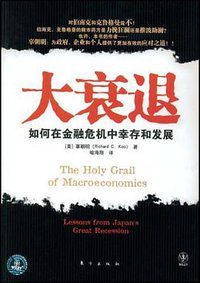The Holy Grail of Macroeconomics
Douban
Lessons from Japan's Great Recession
Richard C. Koo
overview
在线阅读本书
Japan's "Great Recession" lasted from approximately 1992 - 2007 and finally provided the economics profession with the necessary background to understand what actually happened during the US recession of the 1930s. The discoveries made, however, are so far-reaching that a large portion of economics literature will have to be modified to accommodate another half to the macro economic spectrum of possibilities that conventional theorists have overlooked. In particular, Japan's Great Recession showed that when faced with a massive fall in asset prices, companies typically jettison the conventional goal of profit maximization and move to minimize debt in order to restore their credit ratings. This shift in corporate priority, however, has huge theoretical as well as practical implications and opens up a whole new field of study. For example, the new insight can explain fully the precise mechanism of prolonged depression and liquidity trap which conventional economics - based on corporate profit maximization - has so far failed to offer as a convincing explanation. The author developed the idea of yin and yang business cycles where the conventional world of profit maximization is the yang and the world of balance sheet recession, where companies are minimizing debt, is the yin. Once so divided, many varied theories developed in macro economics since the 1930s can be nicely categorized into a single comprehensive theory, i.e., the Holy Grail of macro economics The policy implication of this new discovery is immense in that the conventional aversion to fiscal policy in favor of monetary policy will have to be completely reversed when the economy is in the yin phase. The theoretical implications are also immense in the sense that the economics profession will no longer have to rely so much on various rigidities to explain recessions that have become the standard practice within the so-called New Keynesian economics of the last twenty years.

